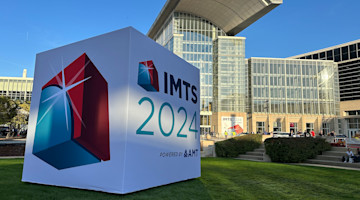Manufacturing technology (MT) is the engine behind strong economies, national security, and public well-being. It drives innovation in everything from clean energy and defense systems to medical devices and transportation. Around the world, countries investing in advanced manufacturing create high-quality jobs, resilient supply chains, and the tools needed to protect and care for their citizens. Simply put, MT is essential for their prosperity, health, and a more secure and sustainable future.
Regions eager to develop their manufacturing base and reap its rewards, like Latin America, India, China, Southeast Asia, and Europe, offer U.S. builders of MT exciting and dynamic business opportunities. To take advantage of these key international markets, AMT – The Association For Manufacturing Technology offers global services to help our members expand sales and strengthen their presence there. Through our Global Tech Centers, we provide business development support, duty-free equipment demos, in-country technical services, and proxy hiring to streamline local staffing, benefits, and legal compliance. With strong regional connections and hands-on support, we help you grow your footprint and succeed wherever opportunity calls.
The Lay of the Land(s)
What’s driving demand for MT around the world? Our AMT Tech Center directors break down the top five industries in their regions, reveal key tech trends, and share insights on the government spending, foreign direct investment, manufacturing policies, and geopolitical forces shaping the landscape. Plus, they’ll spotlight what’s ahead – and what to watch.
Mexico Top Industries
Automotive: The strongest consumer of MT is projected to reach $150 million in production value for parts and assembly in 2025 – even as supply chains are realigned.
Off-highway, industrial machinery, and electronics: Major companies like Foxconn, Flextronics, Caterpillar Inc., John Deere, Polaris, and Freightliner contribute billions in output.
Medical devices and mold and die: These industries boast positive projections as supply chains continue to reshape.
Manufacturing Technology Trends
Demand for cutting tools, fixturing, and automation is increasing as companies realign supply chains.
Interest in U.S. technologies is strong due to Mexico’s proximity and relationship-building potential.
Market, Policy, and Geopolitical Drivers
Mexico President Claudia Sheinbaum’s Plan Mexico strategy promotes SME development and value-added processes.
The United States-Mexico-Canada Agreement, a key trigger of supply chain integration and value-added initiatives, will be reassessed in 2026, offering opportunities for reshoring and regional integration.
In 2024, $2.7 billion in MT consumption was recorded, pointing to strong opportunities for suppliers looking to localize.
Southeast Asia Top Industries
Automotive: The Association of Southeast Asian Nations (ASEAN) is comprised of 10 countries from the region, including some of the world’s fastest-growing economies, and promotes economic and security cooperation. Thailand leads auto production among ASEAN nations, while Vietnam’s VinFast drives EV demand.
Electronics and electrical: This sector sees tremendous FDI, with investments from Samsung, Intel, and Apple, especially in Vietnam and Malaysia.
General manufacturing and machinery: Growth is supported by large investments like Lego’s $1 billion factory in Vietnam.
Aerospace: Maintenance, repair, and overhaul centers have been established in Singapore and Thailand. Malaysia’s aerospace manufacturing sector is growing.
Manufacturing Technology Trends
Southeast Asia (SEA) is seeing strong adoption of smart manufacturing, 5-axis milling, automation, and digital twin technologies.
Demand is rising for high-precision CNC machines, laser cutting, and automated assembly systems.
Market, Policy, and Geopolitical Drivers
Large amounts of FDI are coming into SEA, particularly Vietnam (up 48.6% in early 2025), Malaysia ($19 billion in the first half of 2024), and Thailand (up 38% in 2024).
Some SEA governments may increase U.S. technology purchases to balance trade surpluses.
Tariff uncertainty from the United States could impact export-oriented manufacturing. In August, tariffs on several SEA countries were reduced, including Malaysia (24% to 19%), Thailand (36% to 19%), and Vietnam (46% to 20%).
India Top Industries
Aerospace and defense: These sectors focus on import reduction, domestic production, and defense corridors.
Electronics and semiconductors: Digitization and EV growth drive these sectors; local production meets just 50% of demand.
Automotive: There is huge growth potential with low per-capita vehicle ownership and a strong EV push.
Medical devices: Rapid growth is expected – from the current $15 billion to $50 billion by 2030.
Renewable energy: Large-scale investments are being made in solar, wind, and green hydrogen.
Manufacturing Technology Trends
Industry 4.0 integration, digitization, and automation are on the rise.
The machine tool market is projected to grow from $3 billion to over $5 billion by 2030.
India’s top machine tool-consuming sectors are automotive (35%-40% of overall machine tool consumption), general engineering (20%-25%), and aerospace and defense (10%-12%).
Market, Policy, and Geopolitical Drivers
India has applied the Production Linked Incentive scheme to more than 15 sectors to support domestic growth.
The country’s government initiated massive infrastructure spending on corridors, logistics, and multimodal connectivity.
Free trade agreements have been signed with the U.K., EU, Australia, the United Arab Emirates, and ASEAN, fostering export-led growth.
India’s PMI averages over 56, showing the country’s resilience amid global supply chain instability.
Europe Top Industries
Automotive, aerospace and defense, industrial machinery, electronics, and medical devices lead regional demand.
Central and Eastern Europe attract investment due to cost efficiency and skilled labor.
Manufacturing Technology Trends
Investments are growing in robotics, additive manufacturing, digital twins, and the Industrial Internet of Things.
Germany leads in precision and automation; Italy and France advance in robotics and specialty machinery.
Market, Policy, and Geopolitical Drivers
Driven by the European Green Deal, Horizon Europe, and national recovery programs focused on digital and green technology.
Strategic reshoring initiatives began in response to the Russia-Ukraine conflict.
FDI is high in sustainable manufacturing, semiconductors, and battery production.
Energy costs and supply chain volatility remain challenges.
China Top Industries
Automotive: China, the world’s largest automobile-manufacturing nation, is accelerating EV and ICV production.
Aerospace: Civil aircraft programs like the C909, C919, and C929 are driving precision manufacturing demand.
Automation and robotics: Embodied AI, including humanoid, industrial, collaborative, and mobile robots, is being rapidly adopted.
Renewable energy: Significant investments are being made in nuclear, solar, and onshore and offshore wind energy.
High-end industrial equipment: These are core to China’s industrial infrastructure and national growth strategy.
Manufacturing Technology Trends
China remains the world’s largest machine tool consumer. Top imports include:
Machining centers
Grinding and special processing machines
Gear generators and turning machines
CNC systems, cutting tools, abrasives
Metal-forming machines
Precision metrology and inspection equipment
Market, Policy, and Geopolitical Drivers
China’s manufacturing dominance is underpinned by steady GDP growth of about 5% and strong domestic consumption.
As of 2024, China maintains 31.6% of global manufacturing GDP.
Trade uncertainty with the United States remains as Sino-U.S. tariffs await resolution (as of September 2025).
China’s national policy prioritizes industrial self-sufficiency, high-tech innovation, and the modernization of core sectors.
To read the rest of the International Issue of MT Magazine, click here.






